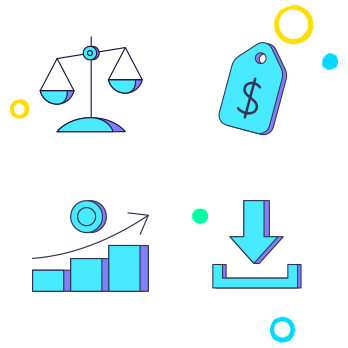Your source for everything mobile UA, from the basics to contentious standards, the glossary can help and inform both aspiring growth managers and experienced mobile app developers

Performance metrics
The Cornerstone KPIs for Mobile UA -> Page 1 of
The Cornerstone KPIs for Mobile UA
Valuable KPIs for running mobile ad campaigns
KPI stands for Key Performance Indicator. KPIs have a measurable value that helps companies understand the effectiveness of their efforts in achieving their key business objectives. In mobile marketing, KPIs are metrics that are used to assess the performance of a marketing campaign.
In this entry, we will focus on mobile marketing KPIs and which indicators are the most valuable for both established apps as well as growing apps and why they are crucial for success.

The importance of KPIs
Setting the correct KPIs is essential to improving app performance and mobile ad campaigns. Examining retention, ROAS, or mid-funnel events (like game levels) can help understand where further improvement can be driven from – if there’s an isolated issue that warrants changes to improve the in-app user experience or if there’s a required change to the way the campaign is managed.
The most basic KPIs are the campaign indicators: impressions, clicks, installs, CTR, and cost. Then there are the in-app indicators: retention, monetization, active users, and events, and the relative and predicted KPIs: LTV and ROAS.
Each app uses different KPIs to measure the success of marketing campaigns, according to its goals. Different apps that rely on different business models may set different KPIs – an app that relies on ad revenue will most likely set retention rate as the most important KPI, while an app that relies on IAP might focus more on ARPU.
Retention Rate
One of the most commonly used KPI is the retention rate. Retention rate is calculated as the ratio of users who opened the app in several time points: install day (day 0), day 1, day 7, and day 30. This metric is used by all apps, regardless of their monetization model, it’s easy to calculate, and provides useful data (such as general app performance, correlation with ROI).
It’s an extremely useful KPI in the increasingly competitive environment of app development – it indicates users’ loyalty to the app (higher retention means users keep choosing to come back to the app instead of its competitors), and when around 70% of users abandon apps on the first day of use, retaining users is challenging and critical, and therefore, retention should always be measured.
Retention rates are important but do not stand alone. There are some caveats to it.
The limitations of Retention Rates
- While it doesn’t take long to gain retention rates (D1 retention is also meaningful), this KPI itself does not stand on its own.
- The retention rate does not account for the length of the session (which may indicate the quality of the user or the quality of the app).
- The retention rate does not factor in the cost to acquire or retain a user. It can be used to deduct the cost of a “retained” user, but retention alone is not enough to conclude costs.
- Following the previous points – high retention rates don’t necessarily guarantee to generate value for the business. Having a lot of users continuously using the app but not making any in-app purchases is nice to have, but not always sustainable as a business model.
Predictive KPIs - How to realize your acquisition potential
ARPU (Average Revenue Per User)
The average revenue per user (ARPU, AKA ARPDAU/average revenue per daily active user) is another useful KPI for mobile marketing. ARPU can help predict the maximum amount that should be paid to acquire a new user and raise a red flag when a campaign is predicted to be unprofitable.
ROAS
ROAS (Return on ad spend) is probably the most commonly used KPI for predicting profitability. ROAS is considered to be more useful than retention rate and ARPU since it incorporates core inputs of profit: revenue generation, as a percentage of the cost. Another advantage of ROAS is that it’s easy to calculate (unlike LTV).
Specifically, week 0 ROAS is as common a KPI as D7 retention. Since it takes only one week, while still capturing data from the different days of the week (thus factoring in the effect different days have on the performance of an ad campaign), and provides predictability, i.e actionable insights.
LTV (Life Time Value)
LTV is at the top of the KPI list and is known for being the most useful KPI for quickly assessing whether a campaign will turn a profit down the line. LTV encapsulates both user retention and monetization, and once it’s established, it’s fast to predict profitability – once CPI or cost per paying user are established.
The reason it’s not as common and widely used as the #1 KPI might be related to some of its disadvantages:
- It requires the app to be established and stable. Even when it’s based as an app, it takes more time and effort to calculate and maintain (requiring dedicated analysts or data scientists), compared to other KPIs.
- There are innumerable ways to calculate LTV and no guarantees as to which way is the most accurate, as with any prediction, it’s an ongoing process with plenty of trial and error.
- Once you have an LTV model you must maintain it – making sure it’s well trained but not overtrained, i.e that your predictions show actual results from a realistic group of users and not the skewed results from your most loyal and lucrative users.
Choosing your key KPIs
The move from D7 ROAS to LTV
When choosing which KPIs should determine your course of action and lead forward your UA campaigns, every marketer needs to consider the state of their app (an established stabilized app, an established app that recently went through a significant change, or an app in growth, that still requires a lot of ‘figuring out’) and choose accordingly.
If your app is still at its early stages and if you’re still changing and developing as you grow, focus on retention and ROAS. Connect them to meaningful events in the user journey and use them as potential indicators, not a full-proof source of truth for the future.
If your app is established and stable, i.e has an established user journey – make use of predictive KPIs, become a soothsayer, know what to expect. This is the time to start using LTV and gain insights into the value of your users in the long run.
ROAS, as previously mentioned, is a useful KPI. It’s not too hard to calculate, it’s predictive (to a degree), it incorporates both cost and revenue, and it can be pretty quick to provide conclusions. LTV is quite a bit more complex and that’s why some app developers may abstain from using it.
Why LTV is worth the effort:
Since mobile app marketing is on the rise and data is becoming more granular, companies need to use the tools at their disposal and choose KPIs that are as relevant as possible to the company’s bottom line.
LTV is not easy to determine (there’s no one way that is the correct way) and will likely require adjustments as the app undergoes major changes, but when it’s set correctly, it can measure gross-revenue and performance over time.
It’s easy to invest time with the KPIs that are right in front of you, like downloads, CTR, impressions, and so on, but if your users aren’t converting, aren’t spending money in-app (or buying a subscription – depending on the monetization model), these interactions have no long-term value. LTV provides an overview of your users and helps determine what are realistic CPAs and CPIs.
